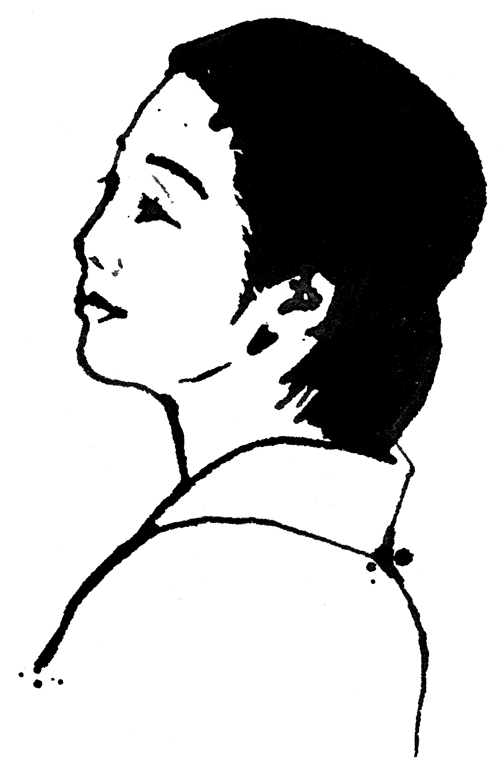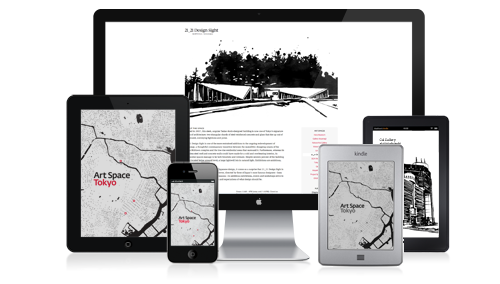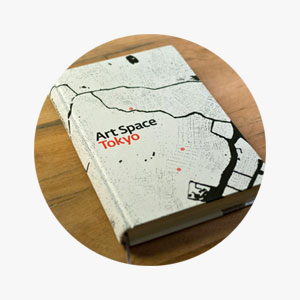
ATSUKO KOYANAGI, director
After graduating from the Department of English Literature at Jissen Women’s University in 1975, and studying Communication Design and Editorial Design at Los Angeles Art Center from 1976 to 1979, she worked at Kazuko Koike’s ‘Kitchen’ office in Tokyo. In 1983 she and Koike opened the Sagacho Exhibit Space. After establishing Gallery Koyanagi as a contemporary ceramics gallery in 1988, she reopened it as a contemporary art gallery in 1995.
What kind of work were you involved in before you opened Gallery Koyanagi?
AK In the 1980s, I was working with Kazuko Koike, whose office handled advertising and cultural affairs for companies like Muji and the Seibu Museum of Art. However, we both started to crave more creative freedom and in 1983 we opened the Sagacho Exhibit Space in an old food warehouse in the Sagacho area, near the Sumida river.
At the same time, my family was running a ceramics shop. My father handled pottery, and I wanted to show the work of ceramics artists, particularly those who worked in contemporary styles. So in 1988, I opened Gallery Koyanagi as a ceramics gallery here in Ginza and ran that for about eight years. That was the precursor to Gallery Koyanagi as it is now.
What led you to reopen your gallery as a contemporary art gallery in 1995?
AKhe mid-1980s was when photography was starting to be appreciated as an artistic medium in its own right. Back then, with the exception of Zeit Photo Salon, Tokyo didn’t have any museums or galleries dedicated to photography. At that time I also met Hiroshi Sugimoto. He was looking for a gallery that would represent him, but had been met with a lot of rejection. I was inspired to show his work and make the shift into contemporary art.
The advertising work I had done at Kazuko Koike’s office until then was in some respects close to photography. I felt I had an eye for this medium and that it would offer me the easiest way to enter the contemporary art world. I hadn’t studied art and I had never worked in another gallery before, so opening my own contemporary gallery was incredibly difficult at the beginning. But it was for that very reason that I felt I was open to involving myself with something new.
From the mid-1990s you became closely associated with other young gallery owners who drove the Tokyo art scene toward recovery. What was the reason for you all grouping together?
AKUntil then there had been no real talk of bringing Tokyo’s galleries together in the same space. There were, of course, a couple of old gallery associations like the Bijutsu Club and so on, but nothing equivalent for contemporary galleries. People working in the contemporary art world tend to be quite individualistic. It wasn’t like we all had to be best friends, but given how small the market was back then, we were stronger and stood out more as a group. It allowed us to introduce each other to each other’s clients. I started to talk to the various galleries about it, and we held a group show at Spiral Garden called G9: New Direction.1
Ever since then the contemporary art world in Tokyo has been characterized by various combinations of galleries grouping together in buildings around the city. What led to the Shinkawa building opening?
AKTomio Koyama was already occupying one of the spaces within the Sagacho Exhibit Space, as were Shugo Satani and Taro Nasu. The Sagacho Exhibit Space was doing very well and in 2001 Shugo Satani and I opened the Rice Gallery by G2 within it, but by then the building had been slated for demolition the next year. Everyone had been working really well together, so we wanted to keep the collaboration going. Koyama-san happened to find the building in Shinkawa, and we moved there in 2003. The Shinkawa building was able to house four of us: Taka Ishii Gallery, Tomio Koyama Gallery, Shugoarts and a showroom extension of Gallery Koyanagi.
At this time the Mori Art Museum was about to open. How did that impact the gallery scene?
AKI was working with Mariko Mori, and at her wedding party I had the opportunity to talk with Minoru Mori. I mentioned to him that abroad, the opening of a major museum tends to attract the opening of commercial galleries around it. The Mori Building Corporation was buying up old buildings in the Roppongi area for future redevelopment, so I suggested to him that it might be interesting to rent out those buildings at reduced rates to galleries that wouldn’t mind their condition. He was interested and straight away he introduced me to the planning division, which suggested a building on nearby Imoaraizaka. It was in a pretty run-down state, so the rent was very cheap. The galleries that couldn’t fit into the Shinkawa building opened up there.
With the map of Tokyo’s contemporary art galleries having diversified so much beyond the Ginza area, are you still happy to have your space in this neighborhood?
AKI was born and raised in this neighborhood and my family business has always been here. I guess if I were starting from scratch now, I probably wouldn’t choose to run a contemporary art gallery in Ginza. But then this building belongs to my family, so there are financial incentives to be here too.
What do you think the future is for Ginza?
AKIn recent years there have been more and more buildings by foreign companies going up and it’s a little sad to see Ginza losing some of its original character. Ginza is one of the most representative, internationally known parts of Japan, and so I have quite strong views on how it should be and a strong desire to protect its status as one of Japan’s most significant areas. Areas like Daikanyama, Aoyama and Roppongi are becoming these very stylish places, so I think Ginza has to keep up. On the other hand, the people running old shops here are working really hard too, so I hope we can achieve a neighborhood with the right balance of new and old.
What do you look for in an artist’s work before deciding to take them on?
AKIt’s not so much what I look for in the artist’s work as what I look for in the artist as a person. Of course, when I encounter a work, I want it to have an impact on me, but it’s who the person behind it is that’s more important. I want to know what they see, what they think, what it is they are trying to convey. The quality of each work that an artist produces may vary, but overall it is a constant process of trial and error that they are engaged with. If I can look at the fundamentals of what they do and feel good about what I see, then I know I can work with them.
I also have to bear my clients in mind. I know what kind of tastes they have and what they are searching for in contemporary art, so when looking at an artist’s work, it’s incredibly important to consider how it fits in with our stable of artists. In general if I like the artist and their work, then my clients will like them too.
What are the strengths and weaknesses of the Japanese contemporary art market?
AKOne of the main reasons the art market doesn’t really grow here is due to taxation laws. In the United States, you get tax breaks if you buy an artwork and eventually donate it to a museum. This is a fantastic system that allows people with money to buy art, enjoy it and then give it to a museum for the benefit of others, and it helps museums enrich their collections. However, there is no such system in Japan: if you buy an artwork here it becomes an asset and you have to pay tax on it.
Another problem is that there are very few big collectors of contemporary art. Perhaps that’s because the market hasn’t fully matured. There are of course serious collectors like Toshio Hara, Minoru Mori and Soichiro Fukutake, but overall there are very few compared to how many you would find abroad.
Compared to other large cities in the world, does Tokyo receive enough funding from the government to support the art world?
AKNot really. The Japanese government has absolutely no cultural strategy when it comes to contemporary art. Of course, when manga suddenly became popular, everybody in the government started to pay attention to Takashi Murakami, and government officials started to use manga as a buzzword, but that’s not the same as having a strategy.
In other countries, like Switzerland, the government pays for the insurance of artworks. Tohaku Hasegawa’s Pine Trees screen is a national treasure, and it was shown in Switzerland last year. The insurance costs for having that work shipped over there must be astronomical and too much for a museum to bear, but it was all covered by the Swiss government. It would be so helpful if there were a system like that in Japan, but there isn’t.
If Japan could give tax breaks for donating to museums and cover the insurance costs of shipping artworks, I think the market here would be able to grow much more healthily.
Broadly speaking, are there any identifiable differences in taste between Japanese and foreign collectors?
AKA lot of artists in Europe and the US make work that really engages with the serious social issues of their time, be it war, economic inequality or racism. Those kinds of problems are more immediate in Europe and the US, and the people who live there deal with them in real time. Correspondingly, there are collectors who truly comprehend their work and buy it. Japan, on the other hand, is not an ethnically diverse society; it has not been at war at all for the past sixty years and in general has had much less social instability to deal with. As Takashi Murakami put it, the Japanese suffer from ‘peace lag’ 2 or have been infantilized; they don’t feel themselves to be very connected to the problems that affect the world.
For example, the wars going on in the Middle East are thought of as America’s problem, and the Japanese don’t feel the same anger toward President Bush as everyone else does. If an artist conveys that anger in a work, then there will certainly be American collectors who will identify with it and buy it, whereas Japanese collectors probably wouldn’t. Of course, some work speaks to everyone through technique alone, but contemporary art is about more than just that; collectors have their conceptual preferences as well.
In Japan there is also a tendency for people to rush toward easily comprehensible art. Gallery owners like Tomio Koyama and artists like Motohiko Odani and Takashi Murakami have been instrumental in making art more accessible to a greater number of people, and I think that’s really good, but it’s equally important not to go too far. I think contemporary art should relate to social issues, and I hope that Japanese collectors will also make the effort to understand the nuances that artists are trying to convey.
How has Japanese contemporary art changed over the past fifteen years?
AKLooking back at how appalling a state the economy was in when I opened my gallery thirteen years ago, I’d have to say the state of the Tokyo art world has changed a lot since then. To talk about these changes simply in terms of prices, fifteen years ago, a small work by Hiroshi Sugimoto would sell for 350,000 yen, whereas now its primary market price at this gallery would be 1.5 million yen. It would then fetch about 5 million yen at auction. A work by Marlene Dumas was worth 350,000 yen back then but now on the primary market her paintings will sell for 3 to 5 million yen; at auction her work would fetch close to 10 million yen. So just looking at the prices you see how much the market has grown. I think the market will grow just as much over the next fifteen years as well.
But whether it’s Murakami, Nara or Sugimoto, these price rises have largely been due to the growth of the international market, so in a sense it’s like they are being imported back into Japan. These works didn’t increase in value through Japanese auctions, but European and American ones. Nevertheless, their sales abroad caught people’s attention here and have encouraged Japanese people to buy.
Another thing that has changed has been the opening of a new generation of galleries here in Tokyo. I’m very happy about this, as it helps encourage young people to get involved in the art world. Before, collecting habits used to be very divided, with only young people buying work by young artists and only established collectors buying work by big name artists, but that has changed. The market has matured a lot.
What about upcoming trends?
AKIn the past Western artists used to dominate everything and both female and Asian artists were a minority. That’s just not the case anymore. Now artists gain recognition simply according to their individual merits. There are also more and more chances for artists to go abroad these days. In the 1980s it used to be that an artist would have to make it big in Japan before going abroad, but now it’s possible to become popular in other places like New York and then come back to Japan, and I think there will be more artists taking that sort of route from here on.
- Held at Spiral Garden from July 22 to 26, 1998, this exhibition went under the subtitle of Tokyo’s art scene as seen by 9 gallerists and featured the work of artists represented by Atsuko Koyanagi, Tomio Koyama, Taka Ishii, Shugo Satani, Hidenori Ota, Tsutomu Ikeuchi and Taro Nasu.↩
- Heiwa-boke in Japanese, a play on the word jisa-boke, meaning ‘jet lag.’↩

